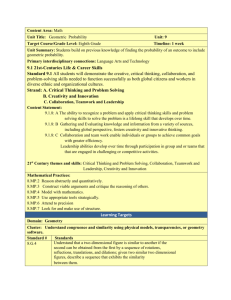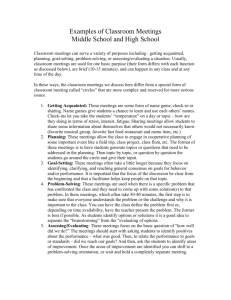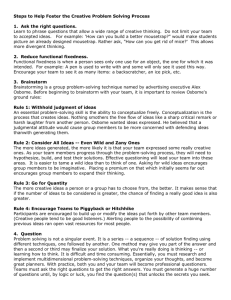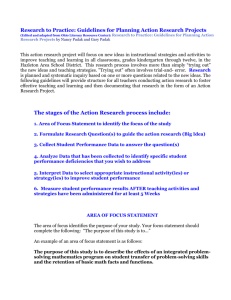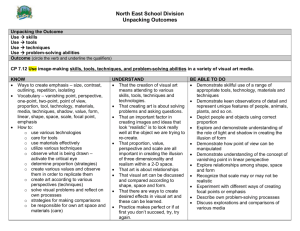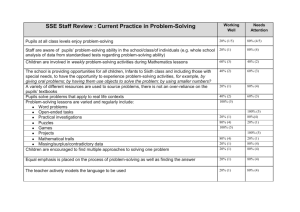Summary Notes - North Carolina Early Learning Network (NC-ELN)
advertisement
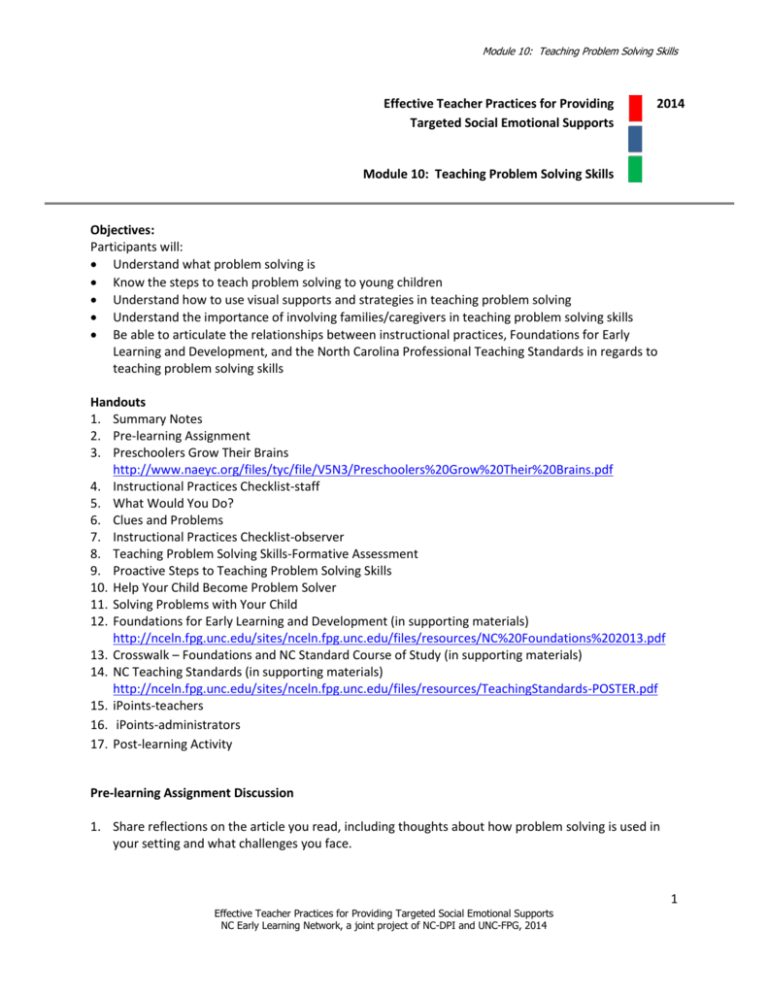
Module 10: Teaching Problem Solving Skills Effective Teacher Practices for Providing Targeted Social Emotional Supports 2014 Module 10: Teaching Problem Solving Skills Objectives: Participants will: Understand what problem solving is Know the steps to teach problem solving to young children Understand how to use visual supports and strategies in teaching problem solving Understand the importance of involving families/caregivers in teaching problem solving skills Be able to articulate the relationships between instructional practices, Foundations for Early Learning and Development, and the North Carolina Professional Teaching Standards in regards to teaching problem solving skills Handouts 1. Summary Notes 2. Pre-learning Assignment 3. Preschoolers Grow Their Brains http://www.naeyc.org/files/tyc/file/V5N3/Preschoolers%20Grow%20Their%20Brains.pdf 4. Instructional Practices Checklist-staff 5. What Would You Do? 6. Clues and Problems 7. Instructional Practices Checklist-observer 8. Teaching Problem Solving Skills-Formative Assessment 9. Proactive Steps to Teaching Problem Solving Skills 10. Help Your Child Become Problem Solver 11. Solving Problems with Your Child 12. Foundations for Early Learning and Development (in supporting materials) http://nceln.fpg.unc.edu/sites/nceln.fpg.unc.edu/files/resources/NC%20Foundations%202013.pdf 13. Crosswalk – Foundations and NC Standard Course of Study (in supporting materials) 14. NC Teaching Standards (in supporting materials) http://nceln.fpg.unc.edu/sites/nceln.fpg.unc.edu/files/resources/TeachingStandards-POSTER.pdf 15. iPoints-teachers 16. iPoints-administrators 17. Post-learning Activity Pre-learning Assignment Discussion 1. Share reflections on the article you read, including thoughts about how problem solving is used in your setting and what challenges you face. 1 Effective Teacher Practices for Providing Targeted Social Emotional Supports NC Early Learning Network, a joint project of NC-DPI and UNC-FPG, 2014 Module 10: Teaching Problem Solving Skills 2. Share reflections on your own practices: What is one area you’d like to improve and a strategy you use that is working well? What is an area in which you would like to “grow your brain”? Effective Teacher Practices for Providing Targeted Social-Emotional Supports: Teaching Problem-Solving Skills Teaching children to solve problems Preschool-age children can effectively be taught problem-solving and conflict resolution skills (Shure & Spivack, 1980, 1982; Webster-Stratton & Hammond, 1997) Self-regulation involves being able to manage feelings, control impulses, and act appropriately It is not until age 5 that children begin to move away from being egocentric. Until then, young preschool children have a hard time understanding that their actions impact the feelings of someone else (Smith, 1993). Teaching children to solve problems It is necessary to teach young children: what to do to keep safe solutions to problems that meet their needs without resorting to violence that if they use aggression to solve their problems, they may win by hurting others. Self-efficacy How would you define self-efficacy? Bert and Ernie at the Movies How did Ernie solve his problem? Were there other options? Objectives See first page of summary Instructional Practices Checklist Find the handout, Instructional Practices Checklist- for staff. Are any of these a challenge for you? We’ll start with the first two: 2 Effective Teacher Practices for Providing Targeted Social Emotional Supports NC Early Learning Network, a joint project of NC-DPI and UNC-FPG, 2014 Module 10: Teaching Problem Solving Skills IP-1: Explicitly teach problem-solving steps IP-2: Engage children in generating solutions to problem-solving steps and possible solutions. Problems are everywhere We will focus on: Problems that occur in social contexts Steps for solving problems and resolving conflicts (they are the same regardless of the type of problem) Problem-solving as a life skill. What Would You Do? Locate the handout titled: What Would You Do? Work with a partner to look over the scenarios and come up with solutions. Write them down and be ready to share. Were all your solutions positive? Did any involve punishment? Were some of your solutions ones you could use in other circumstances? “How can we solve this problem?” is one of the best ways we can give children responsibility for their actions and behavior. NOT punishment or blame. Toddler Rules Not all children develop at the same rate Start at their developmental level. Developing problem solving skills Five and six year old children begin to compete realize someone wins and someone loses experience hurt feelings. They need to learn to express how they feel before they can move on to solving conflicts. We help them understand that the views of others are important (Kreidler and Whittall, 1999). There are multiple problem-solving processes: 3 Effective Teacher Practices for Providing Targeted Social Emotional Supports NC Early Learning Network, a joint project of NC-DPI and UNC-FPG, 2014 Module 10: Teaching Problem Solving Skills basic steps are the same one exception is to add a step for a Cool Down time for those social problems when tempers flare or frustration is high. Basic Steps for Solving Problems 1. 2. 3. 4. 5. 6. Calm down (not always needed, but important when it is needed) Clarify/define the problem Brainstorm solutions Decide on a solution Evaluate the solution Try it out What steps did Ernie take to solve his problem? Help children learn problem-solving steps: Have them observe Practice in everyday activities, such as finding a jacket or wiping up water Direct instruction and scaffolding may be necessary for some children. Step 1: Calm Down Provide support and practice to help the child move from an emotional state to a thinking state Have child tell you how he feels Listen, validate, and reflecting on his feelings Degree of emotional state determines how long or what kind of cool-off period is needed Help children understand that a period to cool off is not punishment. Step 2: Clarify/define the problem Teachers help children develop the communication skills and vocabulary to be successful in all areas, including interactions with peers and conflict resolution (Oertwig & Holland, 2013) Help children develop an emotional vocabulary Model for children how to state the problem -- keep it short and clear Using “and” (rather than “but”) as a connector between what the child wants and the situation validates the child’s position – you might say “You wanted the red marker and Samantha has it.” 4 Effective Teacher Practices for Providing Targeted Social Emotional Supports NC Early Learning Network, a joint project of NC-DPI and UNC-FPG, 2014 Module 10: Teaching Problem Solving Skills Clues and Problems Neutral language helps state a problem clearly without taking a side. Find the handout -- “Clues and Problems.” Work with a partner to read the clues and state what the problem might be. Step 3: Brainstorm solutions Help children brainstorm: Ask, what are you going to do? Tell me some ideas? How could you solve this problem? What could you do that is helpful? Start slowly -- offer two choices Teach children how to put solutions into words Steer clear of making judgments of the solutions Help children determine whether a solution is a good option or not. Basic solutions might include: sharing taking turns find something else to play with get an adult’s help. Step 4: Evaluate the solution Role play and use puppets to help children to think about “What could happen next?” with these guiding questions: Is the solution safe? Is the solution fair? How would everyone feel? Try it out! Some references add this step, “Try it out!” Once the children decide on a solution, let them put it into action Give good descriptive feedback When a solution doesn’t work, guide the children back through the process again When the solution doesn’t work, talk about why it didn’t and start the process over (Bilmes, 2004). 5 Effective Teacher Practices for Providing Targeted Social Emotional Supports NC Early Learning Network, a joint project of NC-DPI and UNC-FPG, 2014 Module 10: Teaching Problem Solving Skills Instructional Practices to Promote Problem Solving Observer Checklist Find the handout, Instructional Practices Checklist for Observers to review while watching this video. At the time of videotaping, this classroom included 17 children age three to five. Four of the children were identified as Exceptional Children: three as Developmental Delay and one as Speech Impaired. Several children were identified with social-emotional needs in the classroom including five children who had been referred for play therapy due to severe emotional trauma. One child was a Dual Language Learner. The classroom staff included one teacher and two assistants. At the time of the videotaping an additional support person was working in the classroom. Video What instructional practices did you see the teacher using? Was she true to the problem solving steps? Would you have done anything different? How did she involve the other child in the solution process? Visual Supports Instructional Practice 3 from the checklist addresses providing visual reminders about problem-solving steps and solutions. Solution kit, solution cards and solution wristlet Solution kits and solution cards are visual supports used in the process of teaching children to come up with multiple solutions to try. When two children are working out a problem, a single solution may not be enough. Solution kit video What did you think of the solution kit? Did the teacher work to help the child find a solution that was acceptable to both girls? How helpful was it to have the visual support of a Solution Kit? If any of you are using Solution Kits or Solution Cards in your classrooms, can you share how they work and any success stories or challenges? Classroom solution strategies This video shows a teacher talking about classroom solution strategies. In her classroom, there are 14 children enrolled, a teacher, one full-time teacher assistant, and one part-time teaching assistant. Both of the teacher assistants were new to the classroom that school year. There were 11 children with IEPs. 6 Effective Teacher Practices for Providing Targeted Social Emotional Supports NC Early Learning Network, a joint project of NC-DPI and UNC-FPG, 2014 Module 10: Teaching Problem Solving Skills Ten were identified as having a Developmental Delay and one was identified as on the autism spectrum. Four of the children in the classroom were supported by NC Pre-K and one child’s family paid tuition. The class included three-year-olds who do not attend every day – therefore you will not see all 14 children in the video clip. Classroom solution strategies video What did the teacher talk about in addition to using the solution steps? Make it Take it Make a visual support of the problem-solving process and the Solution Kit steps. Instructions: Pick up a set of either the Solution Kit/Problem-Solving Steps cards You will also need to get scissors, a hole-punch and a wristlet --please share with the people at your table Cut out the cards Punch a hole in the upper corner of each one Thread each card onto the ring of the wristlet. Formative Assessment When a new skill is taught, we must determine: how well the skill has been learned whether the instruction needs to be changed to assist in learning. The formative assessment process helps us know where we are going where we are now how to close the gap. Formative assessment: a moment-by-moment analysis of children’s learning for the purpose of informing the teacher’s next instructional steps to help children move through learning progressions occurring before, during, and after instruction provides immediate feedback to children. 7 Effective Teacher Practices for Providing Targeted Social Emotional Supports NC Early Learning Network, a joint project of NC-DPI and UNC-FPG, 2014 Module 10: Teaching Problem Solving Skills Pedro the Problem Solver video This video shows the use of Pedro the Problem Solver puppet in circle time to review the possible solutions to problems. At the time of videotaping , this classroom had 15 children, a teacher, and two teacher assistants. There were seven children who had been identified as ‘exceptional:’ four identified as having a Developmental Delay and three identified as on the autism spectrum. In addition, four children were supported by the NC Pre-K program and four children’s families paid tuition. Seven of the children qualified for free or reduced lunch. Video Do the children know the steps? Do they seem to understand them? How do you know? What did you notice about the stick puppet? How does this visual support the children as they go through the process? Would Pedro or a similar puppet help in your setting? Take out the chart in your handouts titled “Developing Problem Solving Skills: Formative Assessment” and reflect upon your video observation. Work with others to enter this information on the handout: Determine a clear learning target Define criteria for success Indicate how you will collect data/documentation and analyze evidence How you would provide clear, descriptive feedback How you might need to change or adjust instruction “Problematize” ‘Sabotage’ as an instructional strategies helps teachers: “problematize” or set up a situation that needs a solution encourage the children to come up with as many ideas as possible guide the children to deciding on one solution to try. Proactive steps: Supporting young children with problem solving in the moment Find the handout called Proactive Steps to Teaching Problem Solving Skills. Take a moment to review the steps. 8 Effective Teacher Practices for Providing Targeted Social Emotional Supports NC Early Learning Network, a joint project of NC-DPI and UNC-FPG, 2014 Module 10: Teaching Problem Solving Skills Family Engagement How might you help families learn the steps of the problem solving process? How might you guide families in understanding how to make problem solving developmentally appropriate for their child? Message in a Backpack Find the “Message in a BackPack” handouts -- Help Your Child Become Problem Solver and Solving Problems with Your Child. How might you use these in your classroom with families? Foundations Look through the domains in Foundations for Early Learning and Development --what indicators in each sub-domain fit teaching problem-solving skills? Crosswalk Find the crosswalk between the early learning and development standards (Foundations) and the NC Standard Course of Study (NC Essential Standards and the Common Core) in your supporting materials. The crosswalks show how the early learning and development standards align with the NC Standard Course of Study, such as: Approaches to Play and Learning Goal 6: Children use a variety of strategies to solve problems. All the indicators for this goal (APL-6n: Seek and make use of ideas and help from adults and peers to solve problems (“How can I make this paint get off my pants?”); APL-6o: Describe the steps they will use to solve a problem; APL-6p: Evaluate different strategies for solving a problem and select the strategy they feel will work without having to try it; APL-6q: Explain how they solved a problem to another person) align with the kindergarten goal in Approaches to Learning Educational Claims for K-3: Students can effectively solve problems by defining goals, describing steps, and evaluating alternative strategies in both academic and social interactions. Another content area for the same Approaches to Play and Learning goal might be NCES Social Studies K-2 preamble & introductory paragraph K-3: Students gain from social studies the attitudes and values that enable them to be effective problem‐solvers, good decision makers, and wise planners. 9 Effective Teacher Practices for Providing Targeted Social Emotional Supports NC Early Learning Network, a joint project of NC-DPI and UNC-FPG, 2014 Module 10: Teaching Problem Solving Skills NC Teaching Standards Find the NC Professional Teaching Standards in your supporting documents. Which teaching standard are you demonstrating when you teach problem solving? iPoints Find the iPoints documents in your handouts. Choose a partner from another table, preferably someone you don’t know. One of you will play the role of the teacher and one will play the role of the administrator. Give the administrator the iPoints for Administrators copy. As the teacher, take three minutes to explain to your administrator how you teach problem solving and how it ties in to the Foundations and the Teaching Standards using the notes you just made. The administrator may ask clarifying questions. After three minutes, switch roles. How did you feel explaining the items on iPoints and talking to an administrator? Could you do this before you are observed? What was difficult? Summary/Conclusion In the book, Beyond Behavior Management, the author Jenna Bilmes says children need to develop a problem-solving attitude and learn problem-solving skills Developing a problem-solving attitude means they believe problems can be solved and trust they can come to an agreement when solving conflicts With adult help, children learn that by problem solving they can manage their emotions, define problems, come up with solutions, and make purposeful choices (p. 180). Questions Post-Learning Activity 1. Take the Instructional Practices for Promoting Problem Solving Teacher/Staff Checklist that you completed as a self-assessment in the pre-learning activity. Select one area you would like to work on. List the three ways you hope to meet your goal. 2. Examine your daily schedule and decide when you will intentionally teach problem solving skills. Decide how you will teach problem solving in a developmentally appropriate way for your children. 10 Effective Teacher Practices for Providing Targeted Social Emotional Supports NC Early Learning Network, a joint project of NC-DPI and UNC-FPG, 2014 Module 10: Teaching Problem Solving Skills Write a lesson plan for teaching problem-solving skills. Include books, role play or puppets, etc. What visual supports will you use in your lesson plan to support children in the problem-solving process? References: Bilmes, J. (2004). Beyond Behavior Management: The Six Life Skills Children Need to Thrive in today’s World. St. Paul, Minnesota: Red Leaf Press. CSEFEL. (2014, April 9). Center on the Social Emotional Foundations of Early Learning. Retrieved from CSEFEL: www.csefel.vanderbilt.edu Gartrell, D. (2004). The Power of Guidance: Teaching Social-Emotional Skills in Early Childhood Classrooms. Clifton, New York: Delmar Learning. Help Your Child Become a Problem Solver. (2012). Teaching Young Children. 5(3). Retrieved from https://www.naeyc.org/tyc/files/tyc/file/V5I2/Help%20Your%20Child%20Become%20a%20Great %20Problem%20Solver.pdf Iowa State University Department of Human Development & Family Studies. (2013). Train-Coach-Train. Retrieved from https://iastate.app.box.com/s/9rg5sxh5mfh43da7e05k Kreidler, W.J. and Whittall, S.T. (1999). Adventures in Peacemaking: A Conflict Resolution Activity Guide for Early Childhood Educators, 2nd Edition. Cambridge, Massachusetts: Educators for Social Responsibility. Levin, D. (2003). Teaching Young Children in Violent Times: Building a Peaceable Classroom, 2nd edition. Cambridge, Massachusetts: Educators for Social Responsibility. North Carolina Department of Public Instruction. (2012). North Carolina Teacher Evaluation Process. Retrieved from http://www.ncpublicschools.org/docs/effectivenessmodel/ncees/instruments/teach-eval-manual.pdf North Carolina Foundations Task Force. (2013). North Carolina foundations for early learning and development. Retrieved from http://ncchildcare.nc.gov/pdf_forms/NC_foundations.pdf Pawlina, S. and Stanford, C. (September, 2011). Preschoolers Grow Their Brains: Shifting Mindsets for Greater Resiliency and Better Problem Solving. Retrieved from http://www.naeyc.org/files/tyc/file/V5N3/Preschoolers%20Grow%20Their%20Brains.pdf Rice, J.A. (1995). Kindness Curriculum: Introducing Young Children to Loving Values. St. Paul, Minnesota: Red Leaf Press. Ritchie, S. and Gutman, L. (2014). First School: Transforming PreK-3rd Grade for African American, Latino, and Low-Income Children. New York: Teachers College Press. 11 Effective Teacher Practices for Providing Targeted Social Emotional Supports NC Early Learning Network, a joint project of NC-DPI and UNC-FPG, 2014 Module 10: Teaching Problem Solving Skills Smith, C.A. (1993). The Peaceful Classroom: 162 Easy Activities to Teach Preschoolers Compassion and Cooperation. Beltsville, Maryland: Gryphon House. Solving Problems with Your Child. (2013). Teaching Young Children. 7(1). Retrieved from http://www.naeyc.org/tyc/files/tyc/Solving%20Problems%20with%20your%20Child.pdf 12 Effective Teacher Practices for Providing Targeted Social Emotional Supports NC Early Learning Network, a joint project of NC-DPI and UNC-FPG, 2014


